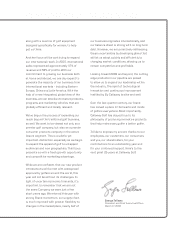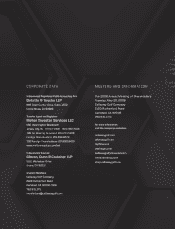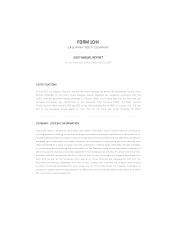Callaway 2007 Annual Report Download - page 17
Download and view the complete annual report
Please find page 17 of the 2007 Callaway annual report below. You can navigate through the pages in the report by either clicking on the pages listed below, or by using the keyword search tool below to find specific information within the annual report.Golf Balls
Prior to the Top-Flite acquisition in September 2003, Callaway Golf manufactured golf balls in its Carlsbad,
California facility and Top-Flite manufactured golf balls primarily in its Chicopee, Massachusetts and
Gloversville, New York facilities. Following the Top-Flite acquisition, the Company began consolidating all golf
ball manufacturing operations. The consolidation allowed the Company to eliminate redundant infrastructure and
overhead while improving functionality. As a result of the consolidation, most of the Company’s golf ball
products are now manufactured at the Chicopee and Gloversville facilities. In October 2006, the Company
entered into a supply agreement to have a limited portion of its golf ball products manufactured overseas
beginning in 2007. See Note 3 to the Consolidated Financial Statements. Overall, although a significant amount
of labor is still used in the golf ball manufacturing process, the golf ball manufacturing process is much more
automated than the golf club assembly process.
For certain risks associated with golf club and golf ball manufacturing, see below, “Certain Factors
Affecting Callaway Golf Company” contained in Item 1A.
Sales and Marketing
Sales in the United States
Approximately 53% of the Company’s net sales were derived from sales within the United States in 2007
and 56% in both 2006 and 2005. The Company primarily sells to both on- and off-course golf retailers and
sporting goods retailers who sell quality golf products and provide a level of customer service appropriate for the
sale of such products. The Company also sells certain products to mass merchants. On a consolidated basis, no
one customer that distributes golf clubs or golf balls in the United States accounted for more than 3% of the
Company’s consolidated revenues in 2007 and 2006 and 4% in 2005. On a segment basis, the golf ball customer
base is much more concentrated than the golf club customer base. In 2007, the top five golf ball customers
accounted for approximately 20% of the Company’s total consolidated golf ball sales. A loss of one or more of
these customers could have a significant adverse effect upon the Company’s golf ball sales.
Sales of the Company’s products in the United States are made and supported by full-time regional field
representatives and in-house sales and customer service representatives. Most of the Company’s geographic
territories are covered by both a field representative and a dedicated in-house sales representative who work
together to initiate and maintain relationships with customers through frequent telephone calls and in-person
visits. In addition to these sales representatives, the Company also has dedicated in-house customer service
representatives.
In addition, other dedicated sales representatives provide service to corporate customers who want their
corporate logo imprinted on the Company’s golf balls, putters or golf bags. The Company imprints the logos on
the majority of these corporate products, thereby retaining control over the quality of the process and final
product. The Company also pays a commission to certain on-and off-course professionals and retailers with
whom it has a relationship for corporate sales that originate through such professionals and retailers.
The Company also has a separate team of club fitting specialists who focus on the Company’s custom club
sales. Custom club sales are generated primarily from the utilization of the Company’s club fitting programs such
as performance centers as well as other, iron and wood fitting carts, and a vehicle with club building capacity. In
addition, during 2007, the Company introduced the Callaway Golf OptiFit System, which expands on the
capabilities of the OptiFit Driver System that was launched in 2006 to now include irons in addition to drivers.
The OptiFit System is a custom fitting system that enables golfers to experiment at participating on and
off-course retail stores with an extensive variety of clubhead and shaft combinations in order to find the driver or
set of irons that fits their personal specifications. The OptiFit System equips retailers and pros with a compact,
hi-tech fitting tool that can quickly identify the precise clubhead and shaft combination for each golfer’s
individual swing, thereby dramatically improving the process in which consumers select a new driver or set of
4
























